We’re still a ways away from NHL free agency, but the class — both for unrestricted and restricted free agents — looks to have some high-end talent. The trade deadline could impact where and how much some players sign for. But paydays are ahead for some notable UFAs and RFAs. For this article, let’s look at the UFAs, with RFAs to follow later in the week.
Jake Guentzel
The Pittsburgh Penguins have not met expectations this season, meaning a retool could be in store in the coming weeks and months. If so, that means Jake Guentzel could sign his next contract with another team, as he will become an unrestricted free agent on July 1 if he doesn’t sign before then.
Guentzel is out of the lineup until around the trade deadline on March 8, but he was having a great season until getting hurt, with 22 goals and 52 points in 50 games. He’s been above or close to a point-per-game player in each of the last five seasons, so his next contract won’t be cheap. At 29 years old, he should have some good hockey left in him, too.
One contract comparable for Guentzel could be J.T. Miller, who signed an eight-year extension with the Vancouver Canucks at a cap hit of $8 million. He was 29 when he signed the extension, though it didn’t kick in until this season. His production was similar to Guentzel’s, too, with 264 points in 277 games in his previous four seasons before signing the deal compared to 266 in 260 for Guentzel, including 2023-24.

A good bet for Guentzel is to end up somewhere in the $8 million range, perhaps slightly above it, and it will be for eight years. He should have plenty of suitors, which may drive up his price, but my best guess is he signs for eight years at a cap hit of $8.25 million.
Sam Reinhart
Talk about balling out during a contract year. Sam Reinhart is having the season of his life, with 39 goals and 67 points in 57 games, putting him on pace to finish with 56 goals and 96 points, which would easily set career highs for the 28-year-old forward.
Reinhart has consistently potted 30-plus and has come close to a point-per-game or above a couple of times in his career. The key, though, is to note that Reinhart has not been a 50 or even 40-goal scorer throughout his career. That should keep his number below $10 million annually, especially if he stays with the Florida Panthers since Florida does not have a state income tax. But his number should be over the $9 million mark.
Related: NHL Trade Bait List for 2024 Trade Deadline
One comparable could be the contract Johnny Gaudreau signed as a 28-year-old with the Columbus Blue Jackets in July 2022. He was coming off a career season that saw him finish with 115 points in 82 games for the Calgary Flames. Gaudreau had never been a 100-point player in his career before signing the deal, but he was consistently close to a point-per-game or above most years.
Gaudreau signed for eight years with the Blue Jackets at a cap hit of $9.75 million. I think Reinhart will come close to that but at a slightly slower number. Panthers or not, let’s say he signs for seven or eight years at a cap hit of $9.125 million.
Elias Lindholm
Elias Lindholm has not had the best season, but with the center market relatively weak this offseason, some team will likely overpay for him. I think it’s unlikely it’ll be the Vancouver Canucks, who acquired him earlier this month in a trade with the Calgary Flames.
Lindholm has performed a little better since the trade, with six points in 11 games. But he is a ways off from the 42-goal, 82-point season he had in 2021-22 alongside Matthew Tkachuk and Gaudreau in Calgary. It’s fair to wonder how much of that production was because of Tkachuk and Gaudreau since Lindholm has rarely produced at that rate other than the 2017-18 season.
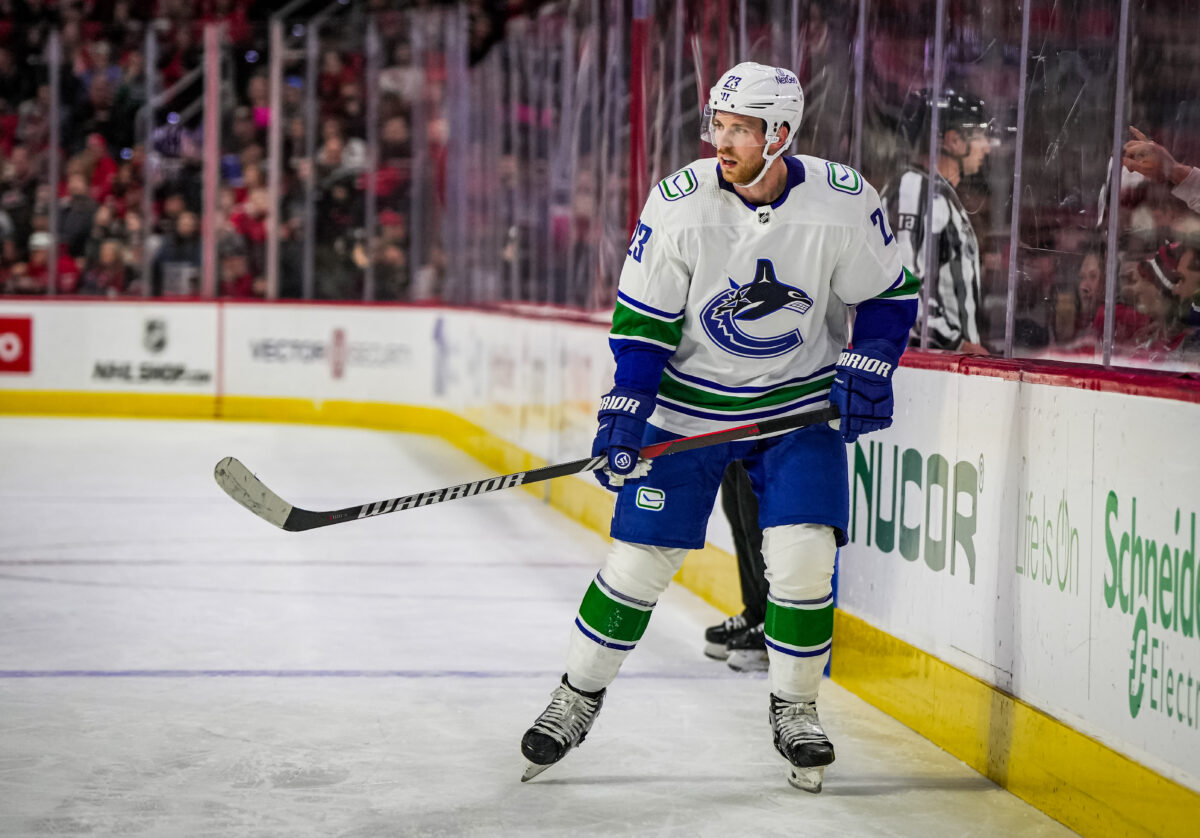
Still, Lindholm is a good player. He’s averaged 68 points per 82 games over the last three seasons and has gained a reputation as one of the better two-way centers in the NHL. His current contract comes with a cap hit of $6 million, so he will get a raise. The question is how much.
One comparable could be Sean Couturier, who signed an eight-year extension with the Philadelphia Flyers in Aug. 2021. That deal came with a cap hit of $7.75 million, and when looking at his production at the time, it seems like a good comp for Lindholm. Couturier had 176 points across 194 games in his three seasons before signing the extension, similar to the 184 in 221 Lindholm has as of this writing.
My best guess is Lindholm signs close to what Couturier signed for, perhaps a little higher. An eight-year, $64 million deal seems like where he could land this summer. Would I pay him that? Probably not, but some team likely will.
Steven Stamkos
Steven Stamkos might be the most fascinating UFA in this class. Not necessarily because he’s the best, but will the Tampa Bay Lightning keep the lifelong Bolt? Or will they let him walk and free up cap space to improve their depth, which has suffered some key losses over the last few years (Ondřej Palát, Alex Killorn, etc.)?
Stamkos’ impacts have fallen off pretty drastically, but he’s still quite productive. He has 23 goals and 50 points in 56 games, and with his shot, he should remain productive, even if he can’t drive play as he once did. As a complementary player, he could be a valuable addition to a Cup contender looking to add more scoring.
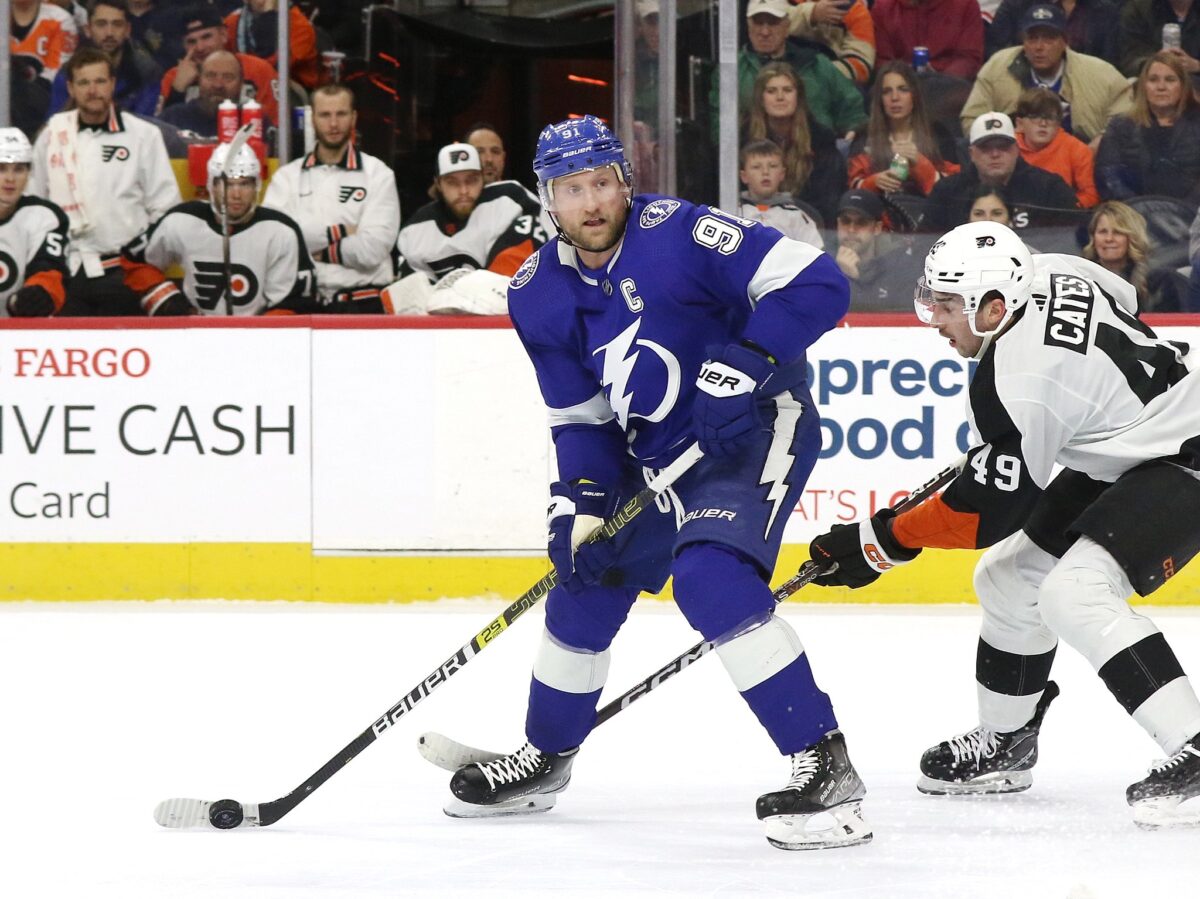
Plus, since he just turned 34 a couple of weeks ago, term shouldn’t be a killer in his next contract, as it’s unlikely he will get anything more than five years; the max I could see is five years, depending on the team he signs with. But admittedly, finding a comparable for him has been a bit difficult.
I don’t know if the Lightning will retain Stamkos or not. It came down to the 11th hour when they re-signed him in 2016, but he was also 26. Julien BriseBois is pretty cutthroat in his decision-making as a GM. If he thinks it’s time to move on, then it’s time to move on. Still, someone will pay Stamkos. I could see something like the three-year, $21 million deal Joe Pavelski signed with the Dallas Stars ahead of the 2019-20 season.
Matt Duchene
After getting bought out by the Nashville Predators this past summer, Matt Duchene has taken advantage of his new opportunity with the Dallas Stars. He has 22 goals and 55 points in 56 games, making for quite the bounce-back season. We’ll see if that means he’s priced himself out of the Stars’ range, but someone will pay him.
Duchene just turned 33 in January, but he’s still got good hockey left in him based on how he’s playing. Like Stamkos, getting a max-term contract seems unlikely for Duchene, given his age. His current one-year deal with the Stars pays him $3 million, so he will likely get a pay raise from whoever signs him this summer.
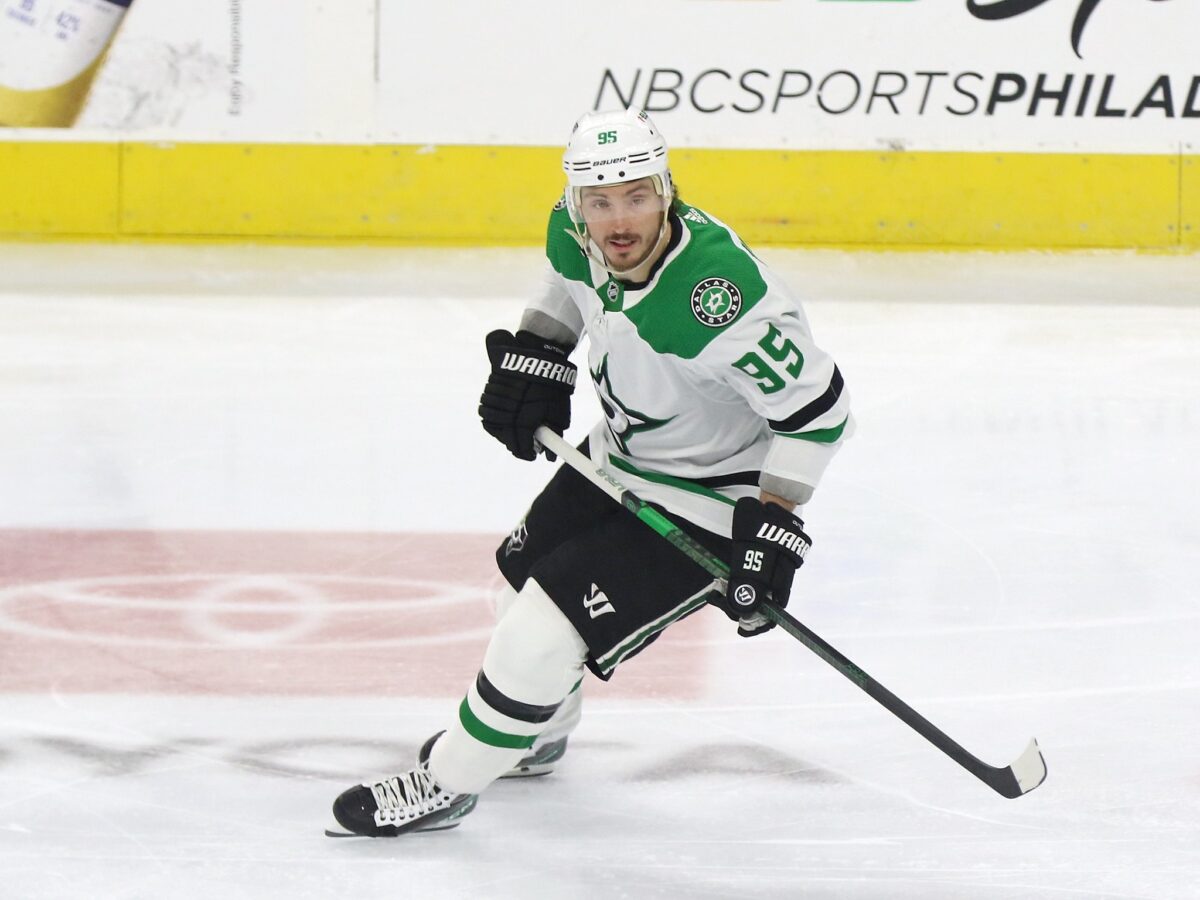
One comparable for Duchene could be the three-year deal Claude Giroux signed with the Ottawa Senators in July 2022 that came with a cap hit of $6.5 million. Giroux had totaled 161 points in his previous 198 games before signing that contract, a bit less than the 197 points Duchene has in his last 205 games.
Giroux was 34 years old at the time he signed that contract. Duchene will turn 34 next season, so it seems like a fair comp. It wouldn’t surprise me if Duchene signs somewhere for three years at a cap hit between $6.5 to $7 million.
Noah Hanifin
The market for defensemen is thin this summer, at least for high-end talent. Players like Brandon Montour, Brett Pesce and Brady Skjei will be good value signings, but they aren’t exactly top-dollar UFAs. Noah Hanifin bucks that trend, though. And it’s possible he could sign an extension with a new team if he gets traded before the March 8 trade deadline.
Rumors earlier this season had Hanifin signing an extension with the Calgary Flames worth $7.5 million a year over seven years. Those obviously fell through, and it seems probable that the Flames will trade him. Unlike the UFAs listed here before, we have a number that was thrown out for Hanifin. But is he worth $7.5 million a year?
Morgan Rielly received an eight-year extension at a cap hit of $7.5 million from the Toronto Maple Leafs. He’s much more of an offensive threat from the back end than Hanifin, but Hanifin has had better defensive impacts than Rielly, especially over the last three seasons:
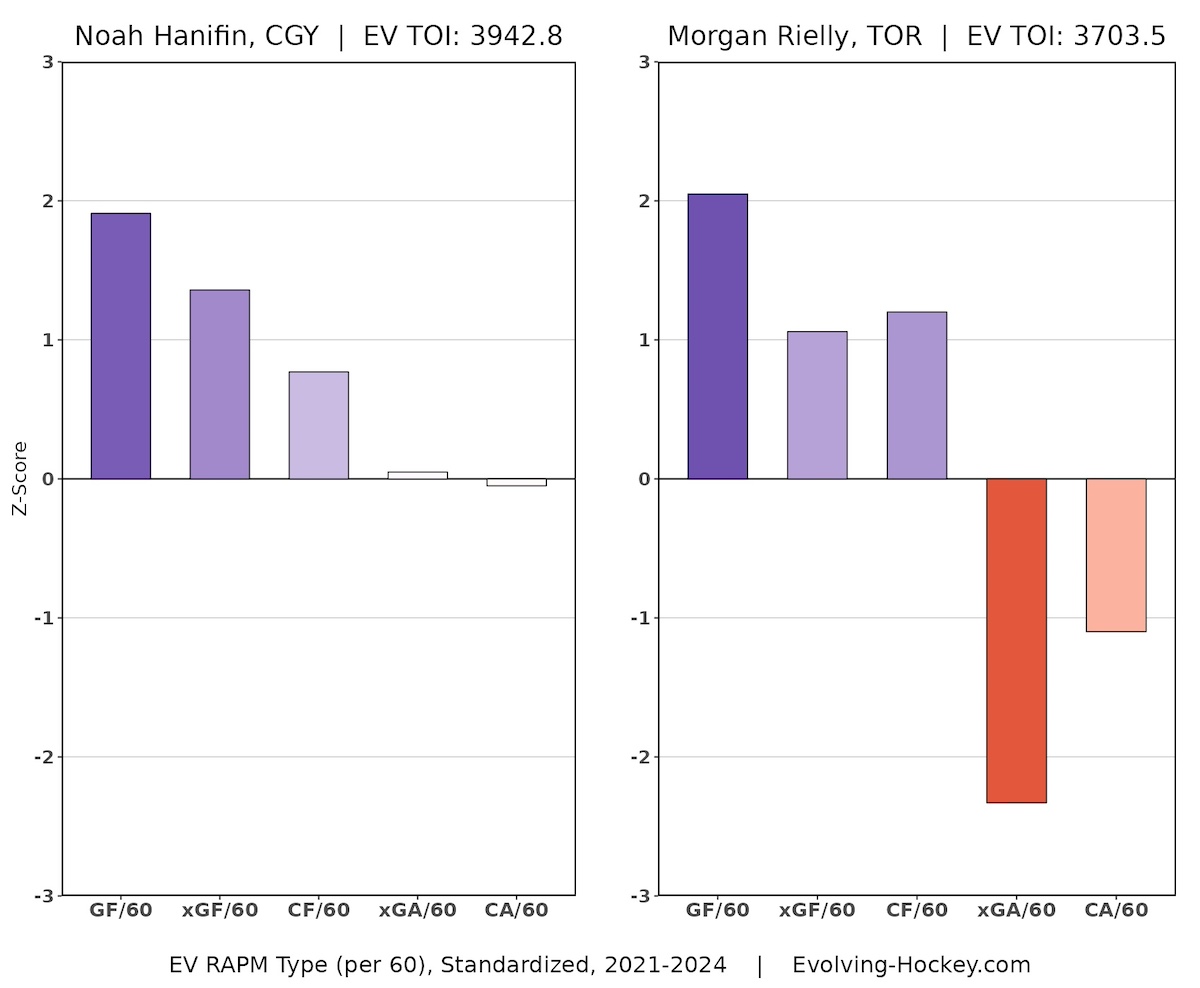
Hanifin is a great defenseman. I think $7.5 million is a bit of an overpay for him, but whoever signs him will likely end up paying him a contract that has a cap hit of $7 million or more. Let’s go with a seven-year deal at a cap hit of $7.125 million.
Patrick Kane
Patrick Kane missed the start of this season recovering from offseason hip surgery, but he looks like the Patrick Kane of old again. In 27 games with the Detroit Red Wings, he has 12 goals and 28 points. His once poor defensive impacts have actually improved, and the offensive flare he’s become known for throughout his career is still there.
We’re dealing with a small sample size with Kane’s Red Wings tenure, but there’s no denying he looks better. He signed a one-year deal with the Red Wings worth $2.75 million and will get a raise from that number. He should get a bit of term, too, even though he’s 35.
There haven’t been many 35+ contracts signed over the last three-plus years. Alex Ovechkin is one, but I don’t think he’s a good comp for Kane. Term-wise, three years seems like a good bet for Kane on his next contract, whether it’s with the Red Wings or another team. His price is a bit difficult to determine, though. This is more vibes than concrete evidence for what Kane could sign for, but a three-year deal in the range of $5.5 to $6 million seems like a decent bet for his next payday.
Tyler Toffoli
Tyler Toffoli has played well for the New Jersey Devils this season and is on track for his second straight 30-plus goal season. Jason Gregor mentioned on the Feb. 22 episode of DFO Rundown that the Devils are trying to re-sign him, but they may have to rethink that position as they plummet in the standings.
If so, he could be a valuable addition to any team looking for top-six scoring. He may not be the fleetest of foot, but he has great hockey sense and a wicked shot. Even though he turns 32 at the end of April, it doesn’t appear he’s in decline yet.
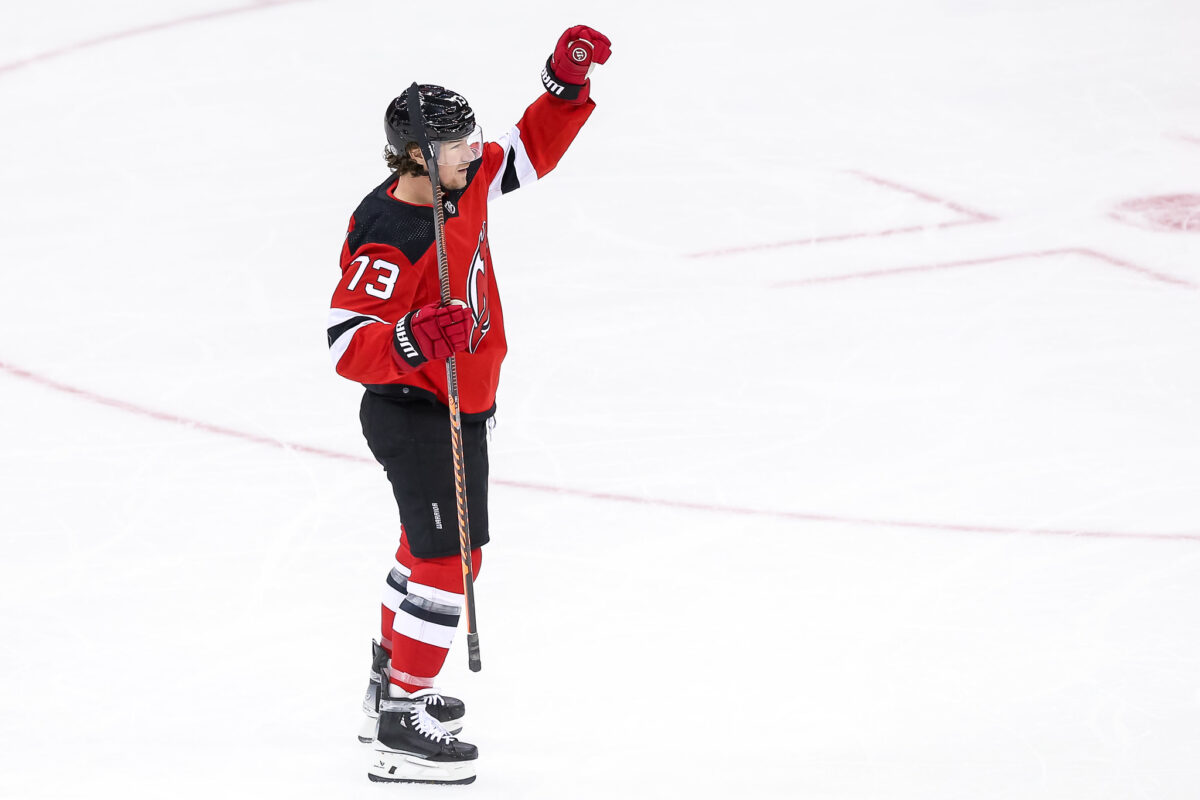
Toffoli’s current contract comes with a cap hit of $4.25 million, so what will potential back-to-back 30-goal seasons do for him? Alex Killorn averaged 25 goals and 58 points per 82 games over his previous seasons before signing a four-year contract with the Anaheim Ducks this past summer at a cap hit of $6.25 million.
Including this season, Toffoli has averaged 30 goals and 63 points per 82 games over the last three years. There are way less red flags in his game than with Killorn, too. Toffoli’s impacts at five-on-five are excellent, and his shooting percentage is sustainable. If he stays with the Devils, it’ll probably be for less than $6 million annually (maybe around $5.5-5.75 million). But he could certainly get $6 million or more on the open market for three to four years.
Jonathan Marchessault
Last but not least, there’s Jonathan Marchessault, who’s having another excellent season for the Vegas Golden Knights. They always seem to find a way to keep the players they want, but it might be tough for them to retain him with their salary cap.
Marchessault has 30 goals and 48 points in 58 games, putting him on pace to finish with 42 goals and 67 points if he plays in all 82 Golden Knights games. His shooting percentage is 15.4 percent, so it’s not unsustainably high; he’s a career 11.4 percent shooter.
Talk about a time to have a career year and not have it come on a shooting bender. Add in Marchessault’s Cup and playoff experience, and he could get a raise on his current $6 million cap hit, even though he’s 33. If it’s with the Golden Knights, it’ll probably come at a discount, but he will likely get more on the open market.
I think Giroux’s contract mentioned previously is also a good comp for Marchessault. Not only are they similar in age, but their production is, too. Marchessault has averaged 64 points per 82 games over the last three seasons, this one included, while Giroux had averaged 66 points per 82 games at the time he signed with the Senators. It wouldn’t be a shock if Marchessault got a similar three-year deal this summer worth $6.5 million annually.
Cap Jump Could Lead to Paydays
Admittedly, this is nowhere near an exact science like what Evolving Hockey does with their contract projections. But using previous UFA signings and comparing production, age, etc., we can try and get an idea of what some of 2024’s top UFAs could sign for when the market opens on July 1. And with the cap rising, paydays should be in store.
